

Exploring Addition Strategies. Yesterday, I blogged about using a 120 chart for adding 2-digit numbers.
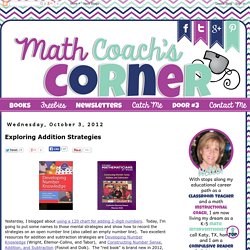
Today, I'm going to put some names to those mental strategies and show how to record the strategies on an open number line (also called an empty number line). Two excellent resources for addition and subtraction strategies are Developing Number Knowledge (Wright, Ellemor-Collins, and Tabor), and Constructing Number Sense, Addition, and Subtraction (Fosnot and Dolk). The "red book" is brand new in 2012, and it's a powerhouse. Incredibly user-friendly, it's a step-by-step manual that will guide you in understanding mental strategies and provide you with instructional and assessment tasks to support your instruction. Montessori Sand Tray - Tips To Promote Writing Success - Planting Peas. Disclosure: This post contains affiliate links (at no cost to you).

This week we did the Montessori sand tray work for the first time. Z (3 years old) is progressing much faster than I expected on his sandpaper letters and numerals work. He knows all of his letter sounds and numbers, and he is already writing over dotted-line letters and numbers using broken crayons. (Click here to see why we use broken crayons.) Tallinjer på Nomp - Nompbloggen. Equivalent Fractions: Understanding the Process. "Recognize and generate simple equivalent fractions, e.g., 1/2 = 2/4, 4/6 = 2/3).

Explain why the fractions are equivalent, e.g., by using a visual fraction model. " Om Abakusen. Abakusen - ett uråldrigt räknehjälpmedel som fortfarande fungerar Räknehjälpmedel i olika former har funnits i många kulturer.
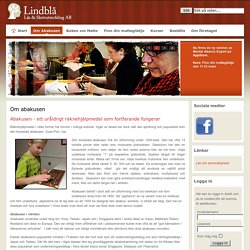
Inget av dessa har dock nått den spridning och popularitet som den kinesiska abakusen, Suan-Pan, har. Comparing Fractions. An important part of being a flexible mathematician is knowing that one size does not fit all.
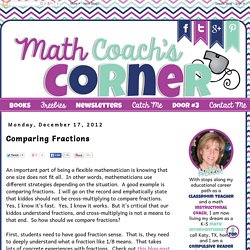
In other words, mathematicians use different strategies depending on the situation. A good example is comparing fractions. I will go on the record and emphatically state that kiddos should not be cross-multiplying to compare fractions. Yes, I know it's fast. Yes, I know it works. First, students need to have good fraction sense. Next, it totally depends on the fractions being compared. Click here to grab a copy of the poster. Another Look at 2-Digit Numbers. A couple of weeks ago, I blogged about working with my firsties on 2-digit numbers.
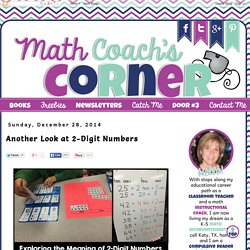
This is a follow-up to that post. Let me reiterate that the idea of tens and ones is not an easy one for young children to understand. Multiplikation och kopplingen till andra räknesätt! Nystart och en möjlighet att i lugn och ro komma igång är bra för alla och främst för eleverna.
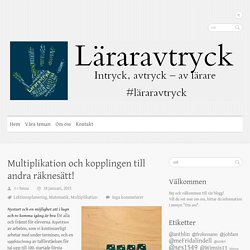
Repetition av arbeten, som vi kontinuerligt arbetar med under terminen, och en uppfräschning av talförståelsen för tal upp till 100, startade första skolveckan i vår åk 2. Eleverna var väldigt taggade och kände genast igen sig när vi startade upp. Shut the Box - Number Sense. This is a paper and pencil version of an old game.

It is fun for young children and anyone can enjoy the game of chance mixed with the fun of finding a strategy. Concrete Learning for Equivalent Fractions. Fractions are such an abstract concept, and kiddos needs lots of concrete and representational (pictorial) experiences to really understand the meaning of a fraction.
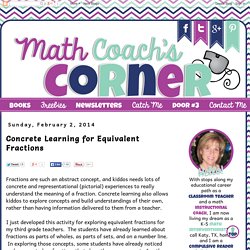
Concrete learning also allows kiddos to explore concepts and build understandings of their own, rather than having information delivered to them from a teacher. Fractions on a Number Line with Cuisenaire Rods. A couple of days ago, I blogged about equivalent fractions, and I promised a follow-up post about fractions on the number line.
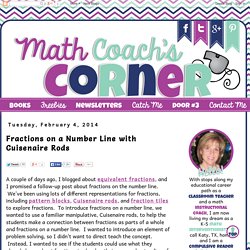
We've been using lots of different representations for fractions, including pattern blocks, Cuisenaire rods, and fraction tiles to explore fractions. To introduce fractions on a number line, we wanted to use a familiar manipulative, Cuisenaire rods, to help the students make a connection between fractions as parts of a whole and fractions on a number line. I wanted to introduce an element of problem solving, so I didn't want to direct teach the concept. Instead, I wanted to see if the students could use what they already knew about fractions to develop their own understanding of fractions on a number line. Students were given the reproducible shown below and set of rods to work with. Developing Fraction Number Sense Through Part/Whole Thinking. It's no secret that fractions are a very difficult concept for students to understand. But why is that? Fractions are an extremely abstract concept, and without adequate concrete and representational experiences, students do not develop mental images of what the abstract symbols mean.
In Texas, students begin formal fraction instruction in 2nd grade under our newly adopted TEKS, but the symbolic notation for fractions (1/4, 2/3, etc.) is not taught until 3rd grade. The 2nd grade standards include: Multiplication Fact Game. A couple weeks ago I posted a fun Bump game featuring the doubles strategy for learning multiplication facts, and today's freebie features more practice on that same strategy. Basically, this strategy makes connections between the 2s, 4s, and 8s. If a student knows 2 x 5 = 10, then 4 x 5 would be double that, or 20, because 4 is double 2. And 8 x 5 would be double 20, or 40, because 8 is double 4. Hence the name of the game: Double, Double, Double. :) Tonight's game features the clip art of Blair Turner.
Click here to download your game. Equivalent Fractions Freebie! The holiday season is approaching--Thanksgiving is just a couple weeks away--and I am again humbled and appreciative of the love and support of Math Coach's Corner followers! Your comments inspire and encourage me, lift my spirits on a down day, and totally validate my faith in the great teaching that is going on in classrooms around the world! I have met such wonderful people through this little blog, and it has grown beyond my wildest dreams!
COMMON CORE: USING NUMBER BONDS TO DEVELOP PART/WHOLE THINKING. Number bonds are powerful tools for helping children learn to compose and decompose numbers. This unit includes instructions for scaffolding learning through three sets of cards: (1) cards with the whole and both parts known, (2) cards with both parts known, but the whole unknown, and (3) missing part cards. A ten-frame mat that can be used with any of the cards for concrete learning is included. Also available as part of a bundle: Common Core: Number Sense/Early Numeracy Bundle Common Core Alignment K.OA.1-represent addition and subtraction with objects K.OA.2-solve addition and subtraction word problems within 10 K.OA.3-decompose numbers less than or qual to 10 K.OA.4-make ten K.OA.5-fluently add and subtract within 5 Be sure to rate this product and provide feedback to earn TpT credits good toward the purchase of future products!
Developing Fraction Number Sense Through Part/Whole Thinking. Spiral Multiplication... a Favorite Game of the Year. Next to my bump games, the favorite game of my students last year was Spiral Multiplication. All you need for the game is a deck of cards (or a section of one) any kind of dice you want your students to use in multiplication, and game pieces. I created this instruction card and printed it on cardstock to give my students easy access to the game rules. Here are some of the boards they loved making: 7 Maths Hacks That Will Change Your Life. Loads of us hate maths, yet basic maths is one of the most useful subjects that we learn at school. Here are some maths hacks to make life that little bit easier. 1. Multiples of 9 works in reverse order. 2.
Your hands can tell you the future … okay, fine, it can tell you multiples of 6, 7, 8, and 9! FREE: ODD AND EVEN NUMBERS. <div class="deployment_message_block"><span> Hi, You need to enable javascript on your browser to use TpT. <a href=" target="_blank">See how this improves your TpT experience</a>. </span></div> About Us | Blog | FAQs & Help All Categories Cart Your shopping cart is empty.